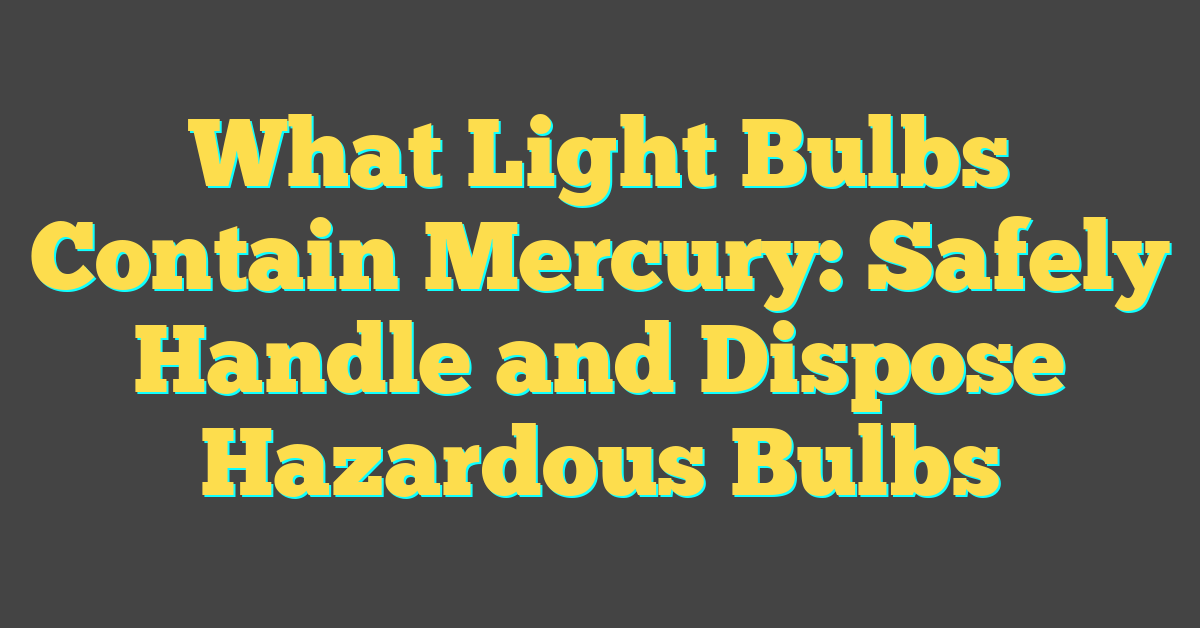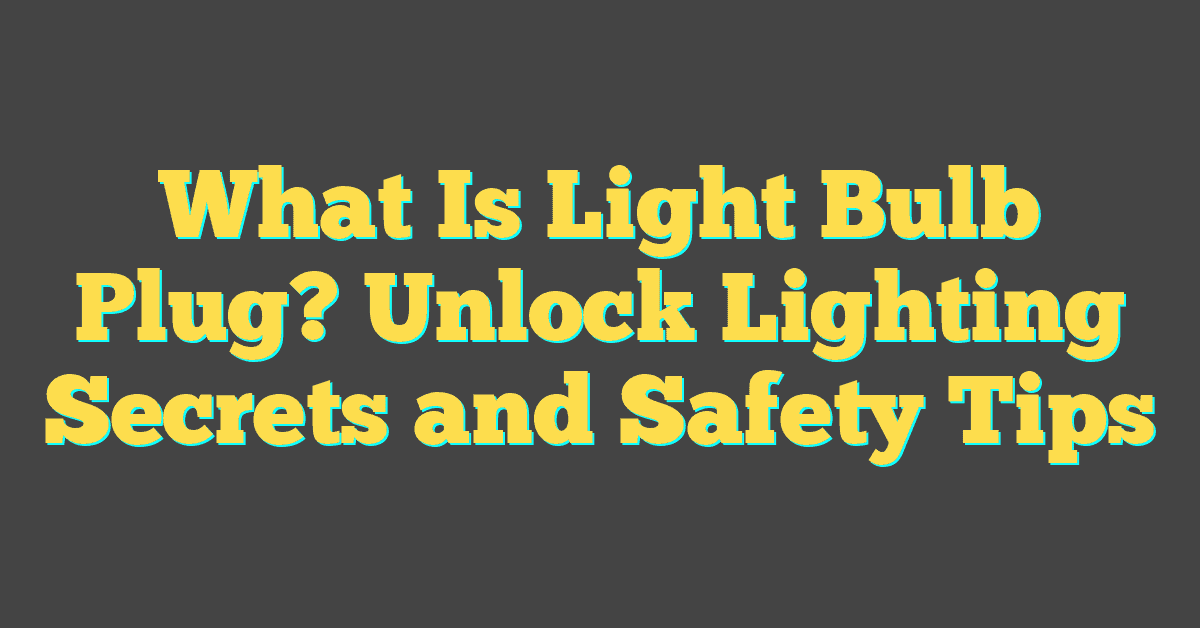Ever wondered why you’re told to handle certain light bulbs with extra care? It’s because some contain mercury, a necessary but toxic element. You’re not alone if you’re curious about which bulbs to watch out for.

Navigating the world of light bulbs can feel like a bright maze of choices. Yet, knowing which ones contain mercury isn’t just smart—it’s crucial for your safety and the environment. Let’s shed some light on the matter.
As you swap out old bulbs or shop for new fixtures, you’ll want to be informed about mercury content. Stick around, and you’ll discover exactly which bulbs to handle with care and why it matters.
What are light bulbs that contain mercury?
As you delve into the world of lighting, it’s crucial to know that not all light bulbs are created equal, especially when it comes to their mercury content. Varieties that contain mercury are designed that way for a reason; it helps them be more efficient or operate properly.
Compact fluorescent lamps (CFLs) are the most common mercury-containing bulbs you’ll come across. They’re the spiral-shaped bulbs you’ve probably seen or used before. While they consume up to 70% less energy than incandescent bulbs, that energy efficiency comes with the trade-off of containing a small amount of mercury.
Fluorescent tubes, often found in kitchens and garages, also contain mercury. These include the long, stick-like tubes as well as the U-shaped ones. Businesses often use them because they’re economical for lighting large spaces—just another example of how mercury is employed to balance cost and efficiency.
High-intensity discharge (HID) bulbs are another category, and these are typically used in outdoor lighting, warehouses, and streetlights. They’re not as common in the average home, but they’re easily recognizable by their high light output and the distinct, sometimes bluish, glow.
Here’s a quick rundown of some mercury-containing bulbs:
| Bulb Type | Typical Usage |
|---|---|
| CFLs | Residential and Office Lighting |
| Fluorescent Tubes | Commercial and Residential Spaces |
| HIDs | Outdoor and Industrial Applications |
Bear in mind that some bulbs are being phased out or improved upon to reduce mercury content while maintaining their performance. It’s always wise to stay informed about these developments, especially if you enjoy DIY projects. Knowing what’s in the bulbs you use can help you make greener choices and dispose of old bulbs safely.
If you come across vintage or imported light fixtures, keep in mind they may also feature bulbs with mercury. It’s the quirky, unexpected finds at flea markets or antique stores that can sometimes throw you for a loop. Always check for any markings or literature that could provide insights into a bulb’s composition.
Why do light bulbs contain mercury?

When you’re on a home DIY mission, getting the lighting right is crucial, and understanding the materials in your light bulbs is part of the deal. Mercury is a bit of a double agent in the world of light bulbs. Its presence isn’t there to cause mischief but to perform an essential role.
Mercury facilitates the illumination process. In bulbs like CFLs and fluorescents, when electricity is passed through, mercury vapor inside the bulb gets excited. This excitement isn’t your run-of-the-mill adrenaline rush; it’s a physical reaction that produces ultraviolet (UV) light. But here’s the plot twist: The UV light itself doesn’t light up your favorite reading nook. Instead, it interacts with a phosphor coating on the inside of the bulb, which then emits the visible light that brightens your spaces.
So, why mercury? It’s incredibly efficient at this job. Alternative materials just don’t match up when it comes to producing a strong, steady light. Plus, mercury enables energy-saving features in bulbs, which aligns with your eco-friendly goals.
- Mercury has a unique atom arrangement that makes it an efficient conductor at room temperature.
- It remains liquid at a wide range of temperatures, ensuring bulb performance in various conditions.
While mercury is a pro at lighting things up, it’s also toxic. That’s the trade-off that’s spurred innovation in light bulb technology. Global efforts are pushing for bulbs that have less impact on the environment without compromising the performance you’ve come to expect. As a lighting and DIY enthusiast, this is critical because it intertwines with your passion for sustainable living and love for well-lit, cozy spaces. You’re already familiar with voltage testers and screwdrivers, so adding safe disposal methods for mercury-containing bulbs to your skill set makes you not just an avid DIYer, but a responsible one too.
The dangers of mercury in light bulbs
« Why Is My Light Bulb So Dim? Uncover the Unseen Reasons and Fixes
Do Light Bulbs Use Less Electricity When Dimmed? Unlock the Truth for Smarter Lighting »

You’re savvy about your home environment and likely aware that certain light bulbs you’ve used for that warm glow in your DIY projects contain mercury. Mercury is a potent neurotoxin, which, even in small amounts, can cause serious health issues.
When these bulbs break, either in your home or after disposal, the mercury released can harm both human health and the environment. In your home, this could mean exposure to mercury vapor. In the environment, broken bulbs can contaminate air and water, eventually making its way into the food chain.
The health risks are particularly concerning for vulnerable populations like children and pregnant women. Mercury exposure can impair neurological development in fetiles and young children, affecting cognition, memory, and fine motor skills. Adults aren’t spared either; mercury can cause kidney damage and respiratory problems over time.
Here’s a surprising fact: it’s not just the broken bulbs that pose a risk. Even properly functioning bulbs emit trace amounts of mercury. While these levels are low, your continuous exposure, especially in poorly ventilated spaces, could be problematic.
With growing awareness, regulatory agencies have taken steps to limit the amount of mercury used in light bulbs and enforce proper disposal methods. You should always follow these guidelines strictly:
- Never throw away mercury-containing bulbs in regular trash.
- Check for local hazardous waste collection sites.
- Consider using a sealed container if a bulb breaks before disposal.
Protecting yourself and the planet starts with understanding these dangers. Armed with this knowledge, you can make more informed choices about the lighting in your spaces and handle these items with the caution they necessitate. Remember, the next time you’re screwing in a light bulb or planning your living room ambiance—the type of bulb you choose matters, not just for your bill, but for everyone’s well-being.
Types of light bulbs that contain mercury

When you’re tackling a home DIY lighting project, it’s essential to know which light bulbs you’re dealing with. Mercury-containing bulbs are not just a single type but come in various styles that are common in many households and businesses. Let’s shine a light on this topic.
Compact Fluorescent Lamps (CFLs) are the most well-known mercury-containing bulbs. These energy-savers gained popularity as a more efficient alternative to incandescent bulbs. They use about 70-90% less energy and can last up to 10 times longer. But that efficiency comes with a caveat: a small amount of mercury enclosed within the glass tubing.
Next, you’ll find fluorescent tubes, those long, tube-shaped lights often seen in kitchens, garages, or office buildings. These tubes, whether standard or slim, also house mercury to help convert ultraviolet energy into visible light. Different sizes, including T8 and T12, are widely used, with the former being a more energy-efficient and less mercury-containing option than the latter.
High-intensity discharge (HID) lamps are another category. Typically found in large spaces like gyms, warehouses, or outdoors for street lighting, HID lamps encompass several types such as metal halide, high-pressure sodium, and mercury vapor lamps. These are not as common in residential settings but are crucial to keep in mind for community or commercial projects.
Specialty bulbs for various industries, like ultraviolet germicidal irradiation (UVGI) lamps used for disinfecting air and water or neon lighting often seen in signs, also use mercury. While these bulbs are less likely to be in your home, they’re no exception when it comes to mercury content.
Bear in mind, newer HID and UVGI lamps are being developed with less mercury content, but they haven’t completely eliminated it. Energy-efficient bulbs are fantastic but always remember to check if mercury is part of the package and handle them with care.
How to handle and dispose of light bulbs containing mercury

When you’re dealing with bulbs that contain mercury, it’s critical to handle them with care. Keep in mind, a broken bulb can release mercury vapor which is hazardous to your health and to the environment. To ensure you’re staying safe, always use gloves when handling these bulbs, especially when they’re spent or damaged. You should securely place the used bulbs in a container that prevents them from breaking during transport.
Disposing of mercury-containing bulbs isn’t like tossing out your regular household waste. These bulbs should never end up in your standard garbage bin. Instead, recycle them responsibly. Most localities have guidelines and facilities where you can bring your mercury-containing bulbs for proper disposal. Here’s a step-by-step guide to help you along:
- Check Local Regulations: Before anything else, look up your local waste management policies. Many areas have specific collection days or drop-off centers designated for hazardous waste.
- Prepare for Transport: Carefully place your used bulbs in a protective container or the bulb’s original packaging to prevent breakage.
- Seal and Label: Seal the container and, if required, label it as containing mercury so waste handlers know to use caution.
- Use Authorized Facilities: Take your bulbs to an authorized recycling center or a household hazardous waste facility. Some hardware stores also offer recycling services for these types of bulbs.
For the more DIY-minded, consider investing in a bulb crusher designed for mercury-containing lamps. These devices safely crush the bulbs and contain the mercury until it can be properly disposed of. However, this should only be done in accordance with local regulations and after thorough research on safe operation practices.
If you accidentally break a bulb, ventilate the area and carefully clean up the debris without using a vacuum, which can spread mercury vapor. Use stiff paper or cardboard to scoop up the fragments, then use sticky tape to pick up any remaining small pieces. Dispose of the debris in a sealed plastic bag and follow your local disposal guidelines for broken mercury-containing bulbs.
Remember that while handling and disposing of mercury-containing bulbs requires extra steps, these measures are key to protecting both your health and the environment. With a bit of preparation and knowledge, you can ensure you’re doing your part in maintaining a safer, cleaner world.
Conclusion
Remember, your safety and the environment’s well-being are in your hands when dealing with mercury-containing light bulbs. Always handle them with care and follow the steps outlined for proper disposal. By taking these precautions, you’re not just following the rules; you’re playing a crucial role in safeguarding your health and protecting our planet. So next time you replace that flickering bulb, give a thought to the safe practices that keep us all shining bright.
Frequently Asked Questions
How should you handle a light bulb containing mercury?
Handle mercury-containing light bulbs carefully by using gloves. Secure them in a container to prevent breakage and follow proper disposal or recycling procedures.
What are the dangers of a broken mercury-containing bulb?
A broken bulb can release mercury vapor that poses health and environmental risks. Mercury exposure can be harmful, requiring careful cleanup and proper ventilation.
Can you dispose of mercury-containing light bulbs in regular trash?
No, mercury-containing light bulbs should not be disposed of in regular trash. They require proper recycling or disposal in accordance with local regulations to prevent environmental contamination.
Is it safe to use a vacuum cleaner to clean up a broken mercury bulb?
No, do not use a vacuum cleaner to clean up a broken mercury bulb. Vacuuming can spread mercury vapor and particles. Follow specific cleanup instructions for safe removal.
What steps should be taken to clean up a broken mercury-containing bulb?
Carefully collect broken pieces, using sticky tape for small fragments and powder. Place materials in a sealed container, ventilate the area, and contact local authorities for disposal instructions.
Where can I recycle my mercury-containing light bulbs?
Recycle mercury-containing bulbs at designated facilities or community collection events. Contact your local waste management authorities or visit Earth911.com for recycling locations.
Is it permissible to use a bulb crusher for mercury-containing lamps?
Using a bulb crusher for mercury-containing lamps is permissible only if it complies with local regulations. Ensure you understand the requirements to avoid legal and environmental repercussions.




